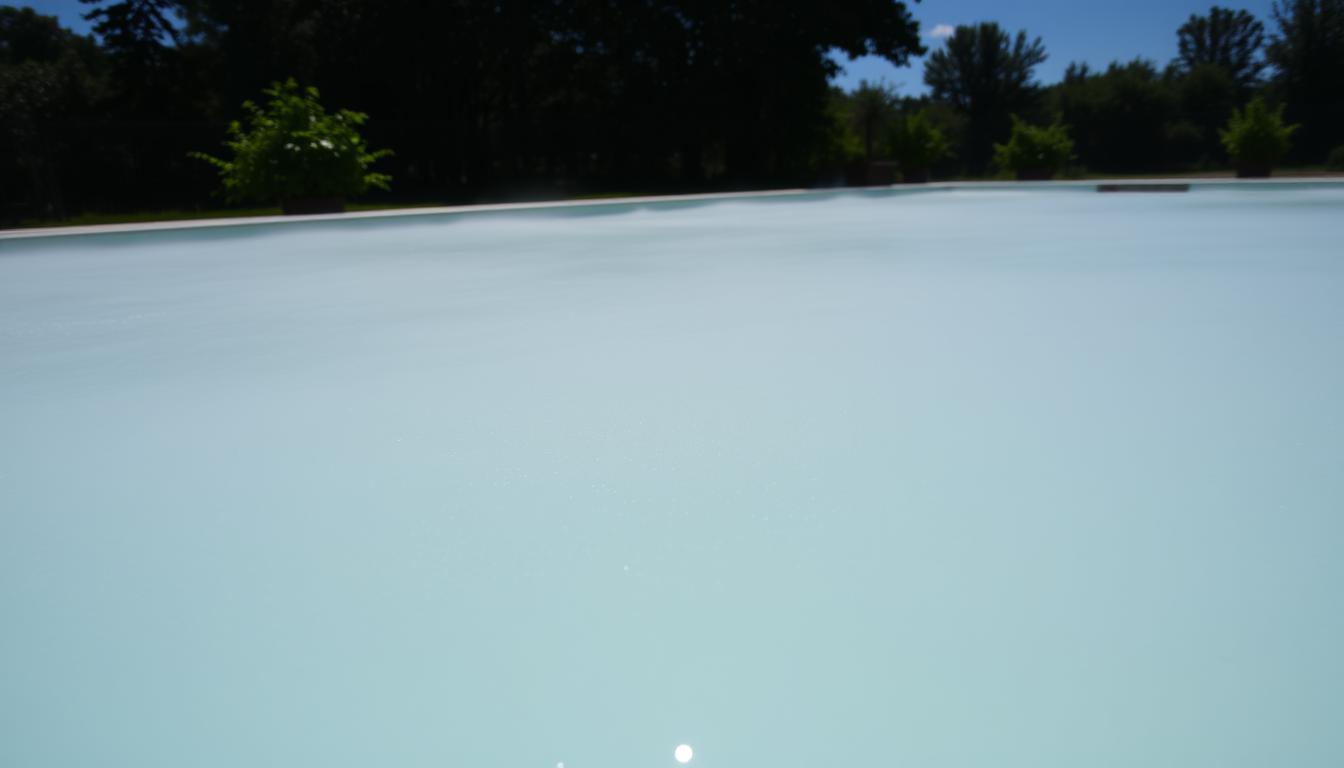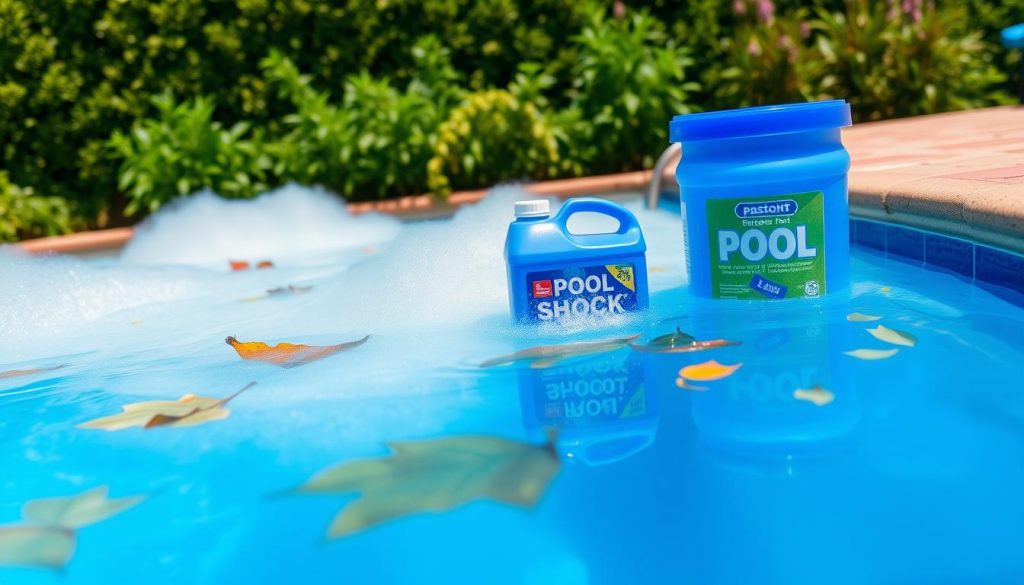
Most pool owners face cloudy water issues at some point. Clear pool water requires consistent effort and attention. Various factors can make your backyard oasis less enjoyable.
Cloudy pool water is frustrating and may signal underlying problems. It makes your pool less inviting and needs prompt attention. Let’s explore common causes and expert solutions for crystal-clear water.
Key Takeaways
- Cloudy pool water is often caused by chemical imbalances, filtration issues, poor circulation, and environmental debris.
- Regular testing and adjusting of pool chemicals are essential for maintaining clear water.
- Shocking the pool, using clarifiers, and running the filter continuously can help clear cloudy water.
- Preventive measures, such as covering the pool when not in use and regular cleaning, can minimize the risk of cloudy water.
- Identifying the root cause of the problem is crucial for implementing the most effective solution.
Common Causes of Cloudy Pool Water
Pool owners strive for crystal clear water. But sometimes, the pool can become cloudy and unappealing. Various factors can cause this issue, from chemical imbalances to environmental elements.
Understanding these causes helps us take steps to restore clarity. This ensures a safe and fun swimming experience for everyone.
Low Chlorine Levels or Chemical Imbalance
Low chlorine is a main reason for cloudy pools. Chlorine keeps water clean and stops bacteria and algae growth. When levels drop, these contaminants thrive, making water hazy.
A pH imbalance can also disrupt chlorine’s effectiveness. This contributes to cloudiness. Proper alkalinity is key too. It stabilizes pH and prevents rapid changes that affect water clarity.
Algae Growth
Early-stage algae can make pool water cloudy. Green, yellow, or black algae multiply quickly if not treated. They thrive in pools with low chlorine, poor circulation, and weak filtration.
Regular brushing, shocking, and balancing chemicals help prevent algae. These steps ensure a clear and inviting pool.
Excess Debris
Leaves, twigs, and insects can cloud pool water. As they break down, they use up chlorine and other cleaning agents. This reduces their ability to keep water clear.
Debris can also clog filters and slow circulation. Regular skimming, vacuuming, and backwashing the filter help maintain a clean pool.
High Calcium Content
Too much calcium can make water cloudy and create scale. Excess minerals can separate from water, causing haziness. Using a clarifier can group calcium particles for easier filtering.
In severe cases, partially draining and refilling the pool may be needed. This dilutes calcium and restores clarity.
| Cause | Effect | Solution |
|---|---|---|
| Low Chlorine Levels | Bacteria and algae growth | Add chlorine tablets or shock treatment |
| pH Imbalance | Reduced chlorine effectiveness | Adjust pH levels with appropriate chemicals |
| Algae Growth | Cloudy water and slimy surfaces | Brush, shock, and maintain proper chemical balance |
| Excess Debris | Chlorine consumption and clogged filters | Skim, vacuum, and backwash filter regularly |
| High Calcium Content | Cloudy water and scale formation | Use clarifier or partially drain and refill pool |
“Cloudy pool water can be cleared in as little as two to three days with proper maintenance.” – Pool Care Expert
Knowing these common causes helps pool owners tackle cloudy water. By using the right solutions, they can keep their pools clear and safe.
This ensures a welcoming swimming environment for family and friends to enjoy.
Diagnosing the Issue: Testing Your Pool Water
Pool water testing is vital for a healthy swimming environment. Test strips or kits check pH, alkalinity, and chlorine levels quickly. These tests help determine the cause of cloudy pool water.
Checking pH and Alkalinity Levels
The ideal pH range for a pool is 7.2 to 7.8. Alkalinity should be between 80 and 120 ppm. High pH can cause filter plugging and circulation issues.
Total alkalinity (TA) imbalances can lead to pH fluctuations. This can result in filter plugging and cloudy water.
| Parameter | Ideal Range | Effect of Imbalance |
|---|---|---|
| pH | 7.2 – 7.8 | Filter plugging, circulation issues, cloudy water |
| Alkalinity | 80 – 120 ppm | pH fluctuations, filter plugging, cloudy water |
Measuring Chlorine Content
Free chlorine levels should be 1 to 3 ppm for effective water disinfection. Combined chlorine (CC) above 0.5 ppm indicates water issues.
Free chlorine (FC) should be at least 7.5% of the pool’s cyanuric acid (CYA). Low chlorine can lead to contaminant spread and water problems.
Chlorine maintenance is crucial to prevent an increase in visual pollutants and cloudiness in pool water.
Identifying Algae Type
Algae can cause hazy and cloudy pool water. Proper water balance and high chlorine levels are needed to solve this.
Identifying the algae type helps choose the right algaecide treatment. This is key to effectively combating the issue.
Regular pool water testing is crucial for clear water. Maintaining proper chemistry and spotting algae growth helps restore crystal-clear pool water.
Solutions for Clearing Cloudy Pool Water
Cloudy pool water can be a real downer. But don’t worry! We’ve got some great ways to fix it. Let’s look at how to make your pool sparkle again.
Running Your Pool Filter Continuously
Good pool circulation is key to clear water. Run your filter non-stop for at least 24 hours. This helps remove dirt and debris that make water cloudy.
Your filter traps contaminants that cause cloudiness. Keep a regular filtration schedule to maintain crystal-clear water.
Shocking the Pool with Chlorine
Low chlorine can make your pool cloudy. A chlorine shock treatment can fix this. It kills algae and removes organic matter that clouds the water.
Follow the instructions carefully when using chlorine shock. This ensures you get the best results for your pool.

Using Pool Clarifiers
Pool clarifiers clump small particles together. This makes it easier for your filter to remove them. These chemicals coagulate tiny contaminants into larger clusters.
Add a pool clarifier as directed on the product label. It can greatly improve your water’s clarity and overall look.
Backwashing the Filter
Regular filter backwash keeps your pool filtration system working well. Over time, filters collect debris that can slow them down. Backwashing flushes out this buildup.
Try to backwash every few weeks. You may need to do it more often if your pool gets heavy use.
Proper filter maintenance, including cleaning skimmer baskets and pump strainers, is essential for optimal water clarity. By keeping our filtration system in top condition, we can prevent the buildup of debris and ensure effective pool circulation.
| Solution | Purpose | Frequency |
|---|---|---|
| Running Pool Filter Continuously | Improves circulation and removes particulates | 24 hours or more when pool is cloudy |
| Shocking the Pool with Chlorine | Eliminates contaminants and restores chlorine balance | As needed, typically every 1-2 weeks |
| Using Pool Clarifiers | Clumps small particles for easier filter removal | As needed, following product instructions |
| Backwashing the Filter | Flushes out accumulated debris and maintains filter efficiency | Every few weeks or as needed |
Use these tips to keep your pool water clear. With regular care, you’ll enjoy sparkling water all season long.
Preventive Measures for Crystal Clear Pool Water
Keeping your pool clean requires a consistent maintenance schedule. Over 50% of pool owners face cloudy water issues. Test your pool water weekly to maintain proper chemical balance.
Aim for a pH between 7.2 and 7.8. Keep total alkalinity within 80-120 ppm. Maintain chlorine levels between 1 and 3 ppm. These levels prevent bacteria and algae growth.
Proper circulation is vital for clear water. Run your pool filter 8-12 hours daily during swim season. This prevents stagnant water and keeps your pool clean.
Backwash sand filters monthly. Clean cartridge filters every two weeks. These tasks prevent common pool problems and maintain water clarity.
Consider hiring a professional pool service for expert maintenance. They can create a custom plan based on your pool’s needs. This ensures you enjoy a crystal-clear pool all season long.







